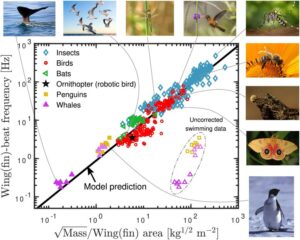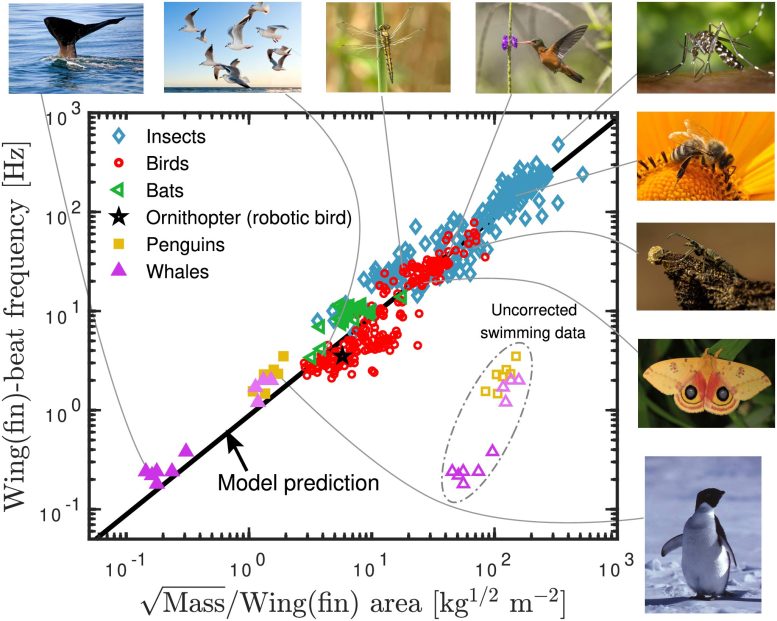According to the findings by research conducted by a team from Roskilde University, one of the most critical breakthroughs has been made to explain the very underpinning mechanics that propel flying and swimming in animals. Specifically, a universal equation was developed to predict wingbeat and finbeat frequency across a wide range of species. Their research is published in the leading publication of PLOS ONE, offering a breakthrough discovery to the biology world with an explanation of how such creatures, from insects up to whales, manage or regulate their movements in such things as air and water. The flight of the insects and the swimming of other animals are two independent phenomena that have evolved in rather different animal groups, entailing their usual and distinctive sets of challenges and adaptations. Biologists have long suspected, however, that deeper connections may exist that are related to the body mass of an animal, wing, or fin area, with the flapping frequency of its wings or the stroking frequency of its fins. It is based on the hypothesis that such movements will have to be attuned to an animal’s physiology, at least theoretically, to achieve the expenditure of the least energy possible on the act, in much the same way as the idea of natural resonance frequency on objects.
The physicists did the dimensional analysis to solve the problem, which yields a derived equation relevant for flying and diving animals. According to the formula that scientists worked out, wingbeats or fin strokes are directly proportional to the square root of the body mass of the animal and inversely proportional to its wing or fin area. This simplicity of relationship sweeps innumerable species, from the smallest insect to the largest whale, differing in size, shape, and evolutionary history.

These findings were tested with ample empirical evidence. They checked their equation’s predictions against published data on wingbeat frequencies for a wide range of fliers, from bees and moths to dragonflies, beetles, mosquitoes, bats, and birds both small and large: from hummingbirds to swans. The same was done with data on fin stroke frequencies for different species of penguins and whales, including humpbacks and northern bottlenose whales. Astonishingly, data fell out that fitted their predictions—the equation is robust across an enormous spectrum of biological diversity.
The researchers then used their equation to infer flight mechanics in extinct species. Thus, they estimated Quetzalcoatlus northropi, a gigantic pterosaur of the Mesozoic, would have flapped these enormous wings at 0.7 hertz—a deduction shorthand made possible by how the equation generalizes from biological data already in existence.
There is yet further potential for applications of the universal equation in technology and engineering in the future. Uncovering the basic principle behind animal motion on land, air, and water, this research can allow improvements to robotics and aerodynamics. The authors surmise that their discovery can make possible better flying and swimming machines, perhaps even nanobots that could negotiate fluid dynamics at small scales.
It is also fantastically simple. It boils down to the fitting of a neat mathematical framework onto complex interactions involving an animal’s physical dimensions and its locomotive behavior. The researchers explained that according to the equation, physics had the power to explain biological phenomena and showed unexpected parallels between creatures as far apart as butterflies and bats.
The results challenge biological dogma, suggesting that underneath a vast array of body plans and behaviors could be one universal, physics-based principle that directly governs flying and swimming. This is a good example to show the power of physics-based discovery, illustrating how convergent natural selection manages to arrive at efficient solutions for the challenges of locomotion—a theme vastly capturing both scientific and engineering imagination over many centuries.
The authors also point out some limitations looking forward. It, according to them, may not work so well in the case of extremely small animals whose dynamics are set by very different physical laws due to their minute size. For animals that swim, gathering complete data was much more difficult and often had to include sources and animal densities estimated from a combination of sources.
However, the team was quite sure that its equation could predict across the animal kingdom. According to researchers, it marks a new high water mark in understanding animal physiology and the evolution of the same, since it can combine this wide range of biological data under one mathematical framework. Thus, they feel that future research could further adjust this equation and quite likely uncover other details about how animals tune their wing and fin motion for top performance.
The overall equation worked out by researchers at Roskilde University indeed, therefore, has the makings of a landmark contribution to integrative biology and physics. This work did something more than light up the mechanics of flight and swimming; it has almost closed a gap between theoretical modeling and empirical data for opening new avenues in interdisciplinary study and technological innovation.
Deeper yet, further research on the implications of the universal equation gives its potential to better grasp evolutionary biology and ecology. It gives a clear framework of relating body mass to wing or fin area and frequency of movement between species, showing that these are evolutionarily developed traits reacting to environmental pressures and selective forces.
The results of this study are of general usefulness for initiatives in conservation biology and wildlife management. Should any of the key mechanics underlying animal locomotion be known, then one could explicitly quantify the health and fitness of free-living populations. An equation such as this for endangered species—major seabirds or marine mammals—might give very valuable information about their energetic requirements and behavior in designing appropriate conservation strategies to do a better job of saving habitat and avoiding extinction events for support over a prolonged period of time.
Further research efforts will be able to fill out what is presented here in the future. A refinement of the equation by integrative physiological data and advances from biomechanics and genetics might push such findings even further. Such discoveries would increase the appreciation of nature but also our ability to apply such principles to technology, medicine, and conservation efforts around the world.
This will thus effectively be a universal equation of wingbeats and fin strokes, giving together biological complexity and mathematical elegance. Its discovery shows just how deep in profundity unity can be in nature’s solution to challenges in movement, giving a glimpse into the convoluted web of adaptations woven into life on Earth. The equation does more to point toward humanity’s quest for knowledge and innovation as scientific investigation continues to unravel the mysteries of animal locomotion, standing by timeless principles of physics and the boundless diversity of life itself.

